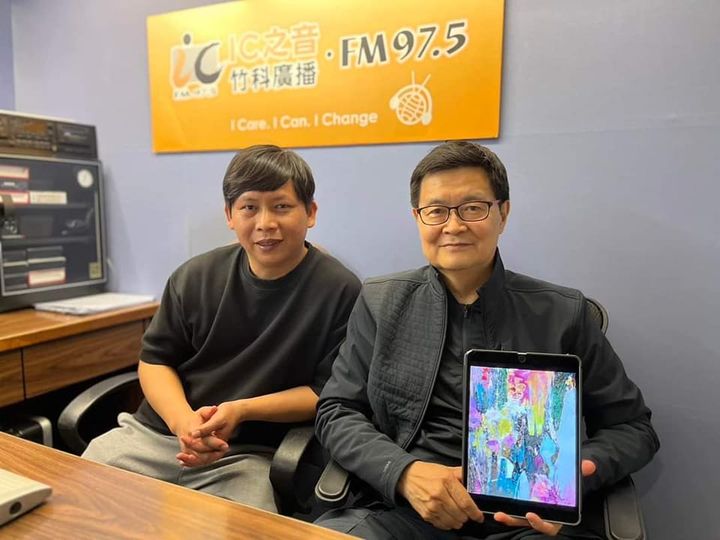IC之音:藝術ABC / 陸潔民主持
藝術家 林宏信 談「繁花」首都藝術中心個展,其展期於5/5-6/3,5/13下午3點有開幕酒會,廣播節目將於5/12、5/19上午8:15至8:45準時播出、歡迎收聽,桃竹苗以外地區請於同時間或播出後任何時間隨選即播網上收聽!
- 桃竹苗地區,廣播電台 FM97.5
- IC之音Broadcast
- Apple Podcast
- Spotify
- KKbox
- Google Podcast
繁花
關於「真實」的再現
具象繪畫的演進,最早是透過是網膜觀察,擬仿再現實物於畫面。照相術的發明,改變了此一再現的軌跡,許多的寫實畫家採用照片為其參照物,甚或直接擬仿再現照片視角、畫面、色彩;此時,人們的眼睛逐漸相信照片是一種真實再現,即便透過光學與化學成像的演化,照片在色調、光影⋯⋯等,已經與實物相去甚遠。
當再現的功能被相機取代,而畫家只是擬仿再現照片的「真實」,一種再現的再現。時至今日,數位化時代來臨,影像透過0與1像素排序而成,人們的眼睛漸漸習慣光彩奪目、多變的影像,加諸影像處理技術的日新月異,以及網路、社群的發達,使影像擁有更多的可能。我們每天不自覺的接觸與習慣數以萬計的影像,成為我們視覺經驗的重要來源,數位影像也成為現今藝術創作者重要的參照,人們的色感來自螢幕上的數位影像,我們所仰賴的「真實」!
主體的模糊虛化與銳利的邊線
試圖採擷這時代共通的視覺經驗,以螢幕(光學)色為作品主要色調構成,並利用多數人習慣的自拍修圖技巧(如美肌、霧化),放棄物體合理的景深,將主體大部分以不合理的柔焦,利用剪貼與去背的方式,將描寫物-花以硬邊的、不合理的合成於平面背景之上,再將類負片的色條拼貼,造成色彩的不斷對比、矛盾,隱喻網路世界的荒誕與視覺刺激。
散佈於背景的色塊,是透過隨機選取去背後,殘留的現實背景,真實被抽離,僅存的殘塊形成了抽象的線條與色面;一如現代生活中,每天囫圇吞棗般的攝取大量的影像資訊,卻難以消化的濫觴。
我們習以為常視網膜的對焦、相機的對焦:主體是清楚的,背景是模糊的;前景清晰,越往後越模糊,主次分明;這樣的視覺體驗,也長期體現在具象繪畫之中。但在此一系列的繪畫中,我試著抽離現實物影像的元素,置入數位影像的處理與模仿光學設色,卻又以繪畫寫實的再現,再刻意反客為主,將主體透過模糊來刻意虛化,邊線與背景反而清晰銳利⋯⋯,而主體透過格放,龐大的量體與「正常」的光影,卻反而使其合理逼近真實的存在。適度的模糊反而有某種熟悉的距離感,適切的距離感或許反而真實⋯⋯,最後又突兀的將畫面靠近中心的位置,擺置一個長方形(或其他形狀)的平塗色塊,嘗試壓制影像的真實性。這是基於何種矛盾的心態?一種自我辯證的過程?或只是無聊的同語反覆?意義的折疊,是否使意義產生質變?不得而知,我也沒有答案。
百花齊放的網路時代
選擇「花」,這個普遍又熟悉的素材,困難的是如何走出前人諸多創作軌跡的巢臼。我試著將「花」本身約定俗成的寓意消去,甚至拆解圖像自身的結構,不刻意擬仿自然元素,如環境、花色、景深⋯⋯;回歸繪畫最基本的問題:色彩、結構、層次、造型、構圖,打破「花」的具象外觀,使其僅成為畫面中一些被拆解的色塊、碎片,抑或構圖的元素。再透過類拼貼的、切割的條狀色塊,試圖在作品中使看似寫實具象的「花」,成為抽象的符號。
因此,在作品中描繪了什麼樣的「花」,對我而言並不具備太多意義,僅是基於造型與色彩的選擇。唯一企圖賦予它的,是一開始發想的來源,基於對自媒體時代、社群、視頻網站中,百花齊放、爭奇鬥豔的現象,與影像充斥帶來的強烈感知。
安迪·沃荷(Andy Warhol,1928 - 1987)曾說:「在未來,每個人都會有十五分鐘的成名時間」(In the future, everyone will be world-famous for 15 minutes.),在這個資訊爆炸、自媒體發達、人人可以利用網路成為名人的時代,似乎貼切,甚有過之!我試著用繪畫來回應處於這個時代的視覺經驗,繁花盛開甚至過剩的年代!
On the Reproduction of “Reality”
The development of figurative painting initially relied on the artists’ visual observation, as they depicted real-life objects through imitation. However, with the advent of photography, the trajectory of representation has shifted. Realist painters now frequently use photographs as their references, often directly imitating and reproducing the perspective, scene, and color of the photographs. As a result, people have come to perceive photographs as accurate representations, despite advances in optical and chemical imaging technology showing that the color tone, lighting, and shadow depicted in photographs can deviate significantly from reality.
As cameras have replaced the function of reproduction, painters are left only to imitate and reproduce the “realness” of photographs, resulting in replications of representations. Today, with the advent of the digital age, images are constructed from binary code, consisting of 0s and 1s, and our eyes have become accustomed to dazzling and varied images. With rapid advancements in image processing technology and the proliferation of the internet and online communities, images have gained even more possibilities. We now unconsciously encounter and assimilate tens of thousands of images every day, which have become a crucial source of our visual experience. Digital images have also become critical references for contemporary artists. Put simply, our sense of color is shaped by what we see on screens, influencing the “reality” we believe in.
Blurred Subjects and Sharp Edges
I aim to capture the contemporary visual experience by utilizing the screen (optical) color as the primary color tone of my work. To achieve this, I apply selfie retouching techniques that are commonly used, such as skin beautification and blurring. I deliberately abandon the traditional depth of field of the subject, opting for an unreasonable soft focus on most of the subject. Through cut-and-paste and chroma key techniques, I merge chosen objects, such as flowers, with hard edges on a plane background in an illogical manner. Additionally, I incorporate color strips similar to those found in negative films, resulting in a continuous contrast of colors and contradictions. These elements are a metaphor for the absurdity and visual stimulation that one encounters in the online world.
The scattered color blocks in the background are the residual fragments of reality that remain after randomly removing the original backgrounds. These fragments of reality manifest as abstract lines and color surfaces, reflecting the predicament that is all too common in modern society. Despite being bombarded with copious amounts of videos and information on a daily basis, we struggle to fully comprehend and process them.
We are accustomed to the way the focus of the retina and the focus of the camera make the subject clear while blurring the background. This effect creates a clearer foreground and a more blurred background. As a result, primary and secondary subjects are easily distinguishable. This visual experience has long been reflected in figurative painting. However, in this series of works, I took elements from real object images, used digital image processing to simulate optical coloring, and then reproduced them realistically on paper. By doing so, I deliberately shifted the focus from the subject to the object, resulting in a purposely blurred subject and sharply defined edges and background. After cropping the image, the subject is highlighted, and its notable volume and “normal” light and shadow make it appear reasonably close to reality. However, appropriately blurring the image can create a sense of distance that feels familiar. This sense of distance can actually be more realistic. To suppress the authenticity of the image, I placed the subject abruptly near the center and added a flat rectangular (or other shaped) color block. What kind of ambivalence is this based on? Does it prompt self-reflection, or it may also be seen as a boring tautology? I wonder if this folding of meaning causes a qualitative change in meaning, but I have no answer.
All Flowers Bloom Together in the Internet Era
The challenge of working with a common and familiar material like “flowers” is how to avoid repeating the ideas of previous artists. To accomplish this, I eliminate the conventional meaning of “flower” and deconstruct the image’s structure by avoiding the imitation of natural elements like environment, flower color, or depth of field. Instead, I focus on the fundamental aspects of painting, such as color, structure, layering, shape, and composition, in order to break free from the figurative appearance of the “flower” and transform it into fragmented color blocks or elements of composition. By using a collage-like approach and cutting strips of color, I look to turn the realistic and figurative “flower” into an abstract symbol in my work.
Therefore, what kind of “flower” is depicted in my work holds little significance to me, as my choice is primarily based on shape and color. I draw inspiration from the way in which all flowers bloom together in the era of we media, especially how images flood various communities and video websites, creating a powerful and impactful perception.
Andy Warhol (1928-1987) once said: “In the future, everyone will be world-famous for 15 minutes.” In today’s era of information overload and we media, his words couldn’t be more relevant, as the internet has the power to turn anyone into a celebrity. As an artist, I aim to capture the visual experience of this era, where all flowers bloom together and everything is overabundance.

藝術家 林宏信 談「繁花」首都藝術中心個展,其展期於5/5-6/3,5/13下午3點有開幕酒會,廣播節目將於5/12、5/19上午8:15至8:45準時播出、歡迎收聽,桃竹苗以外地區請於同時間或播出後任何時間隨選即播網上收聽!